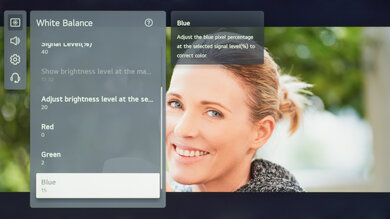- Table of Contents
- Top
- General Settings
- Motion Settings
- Gaming
- White Balance
- Discussions
We used the following calibration settings to review the 65 inch LG UP8000 (65UP8000PUA), and we expect them to be valid for the 43 inch (43UP8000PUA), 50 inch (50UP8000PUA), 55 inch (55UP8000PUA), 60 inch (60UP8000PUA), 70 inch (70UP8070PUA), 75 inch (75UP8070PUA), 82 inch (82UP8770PUA), and the 86 inch (86UP8770PUA) models too. These settings should apply to most types of content, except for gaming or use as a PC monitor, which require a few additional changes, listed below.
General Settings
ECO SETTINGS
One of the first things we did was disable all of the Power Saving and automatic image modes, as we don't want the TV to adjust the image during testing. For this TV, we set Energy Saving Step to 'Off', and from the AI Service menu, we set AI Brightness Settings to 'Off', and we also disabled Reduce Blue Light in the Picture's Advanced Settings menu. You should adjust these settings to your preference.
SDR
For SDR content, there are nine preset picture modes. We recommend choosing the 'ISF Expert (Dark Room)' Picture Mode, as it's the most accurate one out of the box and allows for the most customization. If you watch in a brighter room, 'ISF Expert (Bright Room)' is almost as accurate.
In the Brightness tab under the Advanced Settings, we recommend setting the Contrast to '90', Gamma to 2.2, and leave Auto Dynamic Brightness off. To adjust the TV's luminosity, you should adjust the Panel Brightness setting depending on your specific viewing conditions; changing this setting doesn't impact the overall picture quality. The Screen Brightness setting adjusts the image itself, not the TV's luminosity. We usually recommend leaving this at '50'.
In the Color tab, we recommend setting the Color Depth to '50' and the Color Gamut to 'Auto Detect', so this TV will choose the proper color gamut depending on the content. We chose the 'Warm 50' Color Temperature, which was the default for some picture modes.
HDR
HDR is automatically enabled for the native apps. Once you start playing HDR content, some of the settings change automatically. We recommend leaving these settings to their default settings in HDR.
For HDR to work from external devices, the HDMI Deep Color option usually has to be enabled from the HDMI Settings menu for the input you are using. Older devices may have compatibility issues if this option is left enabled, so we only recommend enabling this setting for devices that require it.
HOW TO MAKE HDR BRIGHTER
If you find HDR content too dim, there are a few things you can try. Set Dynamic Contrast to 'High' and Backlight to their max, and using these settings, the image is brighter as you can see the EOTF here.
Motion Settings
Although we disable most motion enhancing functions for most of our tests, you should adjust these to whatever looks best for you. Some settings, like motion interpolation settings, may need to be adjusted depending on the specific content you're watching.
MOTION INTERPOLATION
Although we usually leave these settings disabled during testing, you should adjust these settings to your liking, as different people prefer different levels of motion interpolation. If you want to enable motion interpolation, set TruMotion to 'User' in the Clarity tab, and adjust De-Judder.
JUDDER SETTINGS
This TV is able to remove 24p judder from all sources, including Blu-rays and native apps. To do so, simply enable the Cinema Screen setting in the Clarity settings menu.
Gaming
From the base SDR and HDR settings, very few changes are required for a great gaming experience. It supports Auto Low Latency Mode, which is enabled by turning on Game Optimizer from the 'Additional Settings' menu. Once this setting is enabled for the input you are using, the TV should automatically switch to the 'Game' Picture Mode when it detects a game is being launched and switch out of it when you stop playing. This setting also turns on HDMI Deep Color for HDR gaming. The Prevent Input Delay setting is meant to further decrease input lag, but it's grayed out and inaccessible on our unit. It's likely that it's only available on the 82 and 86 inch models.
PC GAMING/DESKTOP USE
For an optimal PC gaming experience and proper chroma 4:4:4 support, it's important to set the input label to 'PC' for the HDMI port you are using. Once you have set the label it's recommended to reapply our base SDR or HDR settings, as the picture modes change when you set the label. You can do this from the new 'Home Dashboard' menu. Depending on the format you are sending, it might also be necessary to enable the HDMI Deep Color setting for the port you are using.
White Balance Settings
The following are the results of the white balance and colorspace calibration on our unit. They are provided for reference, and should not be copied as the calibration values vary per individual unit even for the same model and same size as the TV we reviewed due to manufacturing tolerances. If you want to try them you will need to enter all values shown, as all of them are active at the same time. If you end up with worse picture quality, simply reset them to the default values.














































































